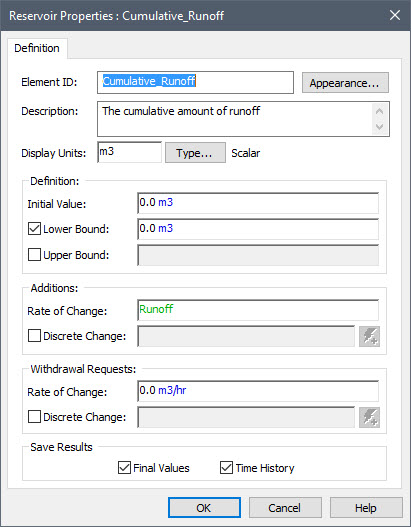Courses: Introduction to GoldSim:
Unit 6 - Carrying Out a Dynamic Simulation
Lesson 7 - Exercise: Calculating the Cumulative Runoff
We are now ready to do our next Exercise (and the first one involving dynamic simulation). We are going to start with the model we built in the previous Unit. You should have saved that model and named it Exercise1.gsm. Open the model now. (If you failed to save that model, you can find the Exercise, named Exercise1_Runoff.gsm, in the “Exercises” subfolder of the “Basic GoldSim Course” folder you should have downloaded and unzipped to your Desktop.)
Recall that in that model, we calculated the volumetric runoff rate (volume/time) during a rainfall event by multiplying the rainfall rate (length/time), the area of the region of interest, and the (dimensionless) fraction of rainfall that run offs (referred to as a runoff coefficient). Note that there was no reason to “run” that model, as nothing was changing with time and we were just doing a one-time calculation.
For this Exercise, what we want to do is quite simple. Starting with the simple runoff model, we want to compute the cumulative volume of water that runs off over a 48 hour period. Given what we have described in the previous Lessons, you should realize that all you need to do to build this model is add a Reservoir element that represents the cumulative volume of water that runs off, with an Addition that is equal to the runoff rate (and a Withdrawal Request of zero).
Go ahead and build the model now, but don’t try to run it yet. We need to discuss the process of running a model before we do so, and we will do that in the next Lesson.
Stop now and try to build the model.
Once you are done with your model, save it to the “MyModels” subfolder of the “Basic GoldSim Course” folder on your desktop (call it Exercise2.gsm), as we will run this model in the next Lesson. If, and only if, you get stuck, open and look at the worked out Exercise (Exercise2_Cumulative_Runoff.gsm in the “Exercises” subfolder) to help you finish the model.
Now let’s look at the Reservoir element that you added. It should look something like this:

Two things should be noted:
- The Rate of Change in the “Additions” section is the runoff rate that you computed in the first Exercise.
- The integral of a volumetric rate is a volume, so you will see that the Display Units for the Reservoir must be a volume.
In the next Lesson, we will run this model and view results.
